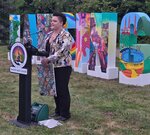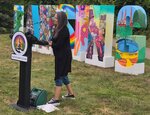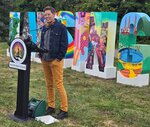






MONDAY, Sept. 23 — “A” is for Azya.
Azya is a former student of Teresa Dunn, an associate painting professor at Michigan State University. Dunn was one of seven artists chosen to paint the “Hollywood”-like LANSING sign unveiled today at the corner of Saginaw Street and Grand Avenue. Ayza was Dunn’s subject for her letter, “A.”
“I chose her because she's a strong woman, she's confident, she's proud of her Blackness,” said Dunn, who has taught at MSU since 2006. “It was really important to represent that kind of diversity, which is a foundation of the city of Lansing.”
Dunn and six other local female artists each crafted their own unique pieces for one of the 6-foot-high letters. Emily Wilson designed the “L,” Jasmyne Wells “N” No. 1, Cait Schneider “S,” Sara Pulver “I,” Theresa Rosado “N” No. 2 and Marissa Tawney Thaler “G.”
The project was the result of a $30,000 grant from the city’s Saginaw Avenue Corridor Improvement Authority and $10,000 from the Michigan Economic Development Corp.’s Community Development Fellowship.
Each letter pays homage to different aspects of Lansing’s historical identity in different art styles. Viewed as a whole, the pieces are cohesive in their shared vibrancy, with the paintings sometimes bleeding into the third dimension beyond their frontward faces.
Rosado, director of the Casa de Rosado Galería and Cultural Center, took great care to ensure that her Hispanic-inspired letter “N” featured prominent Hispanic figures in Lansing’s history, such as former Mayor Tony Benavides and artist Rosa Lopez Killips.
“A lot of people don't know our Hispanic historical figures in Lansing. They're not represented, they're not talked about, they're left out frequently. So, for me, this is a way of making sure we have our foot in the door,” Rosado said.
Wells, who designed the first “N,” came to the table with a concept already laid out on a canvas ripe with some of the city’s most iconic places and things.
“It was actually a process of elimination,” Wells explained. “I had so many ideas of what I wanted to include in terms of what could possibly represent the city — not only my personal experiences, but those around me and those I love. So, there are things I added in the final design that weren't on my original, such as Quality Dairy and Sexton.”
Schneider, an experienced urban farmer and muralist, decided to incorporate her own experiences with sustainable produce on her “S.”
“I represented on my letter the vibrancy, diversity and strength that Lansing draws from through its community gardens, its farmers markets and its public events at community centers,” Schneider said. “We're talking a lot about place making, and I feel like the people who are growing food and selling food are doing that in a real, tangible way, and Lansing is really beautiful because of it.”
Rounding out the sign was Tawney Thaler, who homed in on a more recent development in the effort to maintain and preserve Lansing’s history for future generations.
“I chose to depict the historic Moores Park Pool with the stacks in the background. This pool and the restoration project around it has meant a lot to a lot of disenfranchised people. On the south side, there are a lot of people who feel like they get left out of a lot of decisions. This is such a huge gem to the community, and I chose to depict it because of the palpable excitement around its restoration right now,” Tawney Thaler said.
Lansing Mayor Andy Schor noted that one of his goals is to show off more of Lansing’s creative community for visitors and residents alike. He was impressed to see the final product after seeing bits and pieces of the concept art in recent months.
“We've seen it in writing and on drawings, and we’ve kind of been told what it's going to look like, but until you see it yourself, you don't realize the power of this piece of art,” Schor said. “I have seen these in other cities, and we've said, ‘This would be really important to have here, but let's do it right.' Let's not just have the letters, let’s have the letters showing off our local artists and the excitement, color and vibrancy of our city.”
Support City Pulse - Donate Today!
Comments
No comments on this item Please log in to comment by clicking here